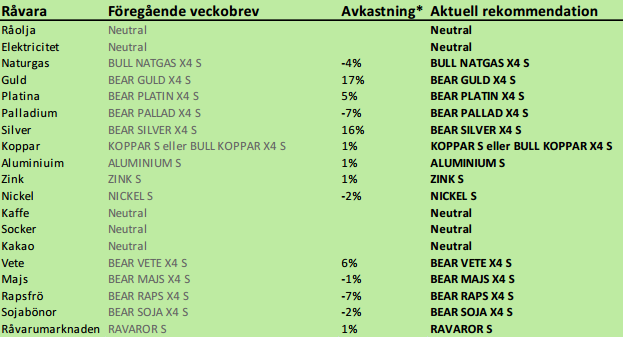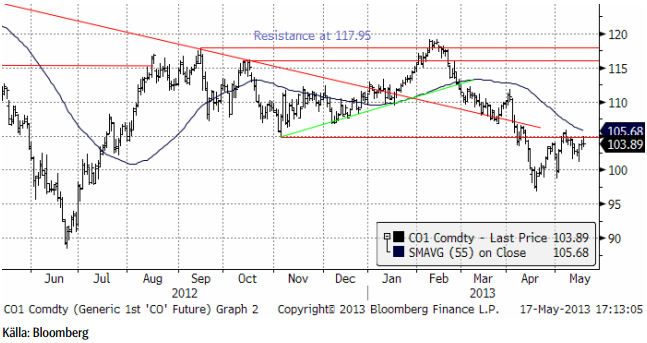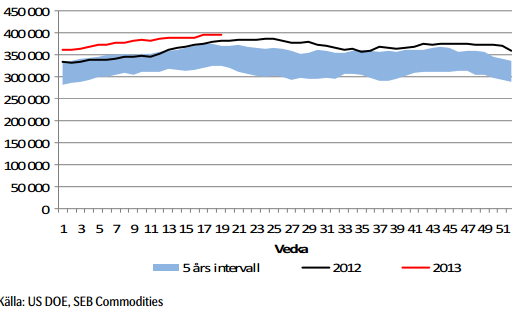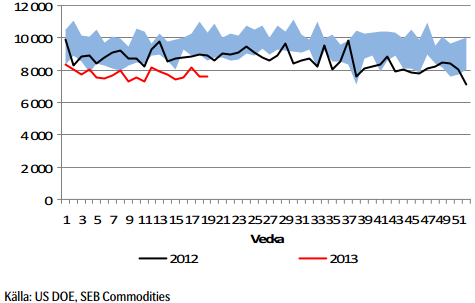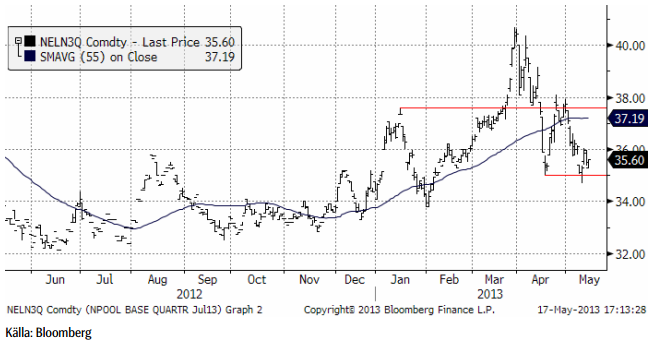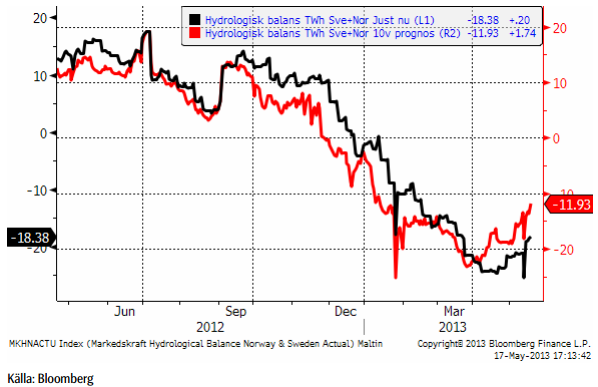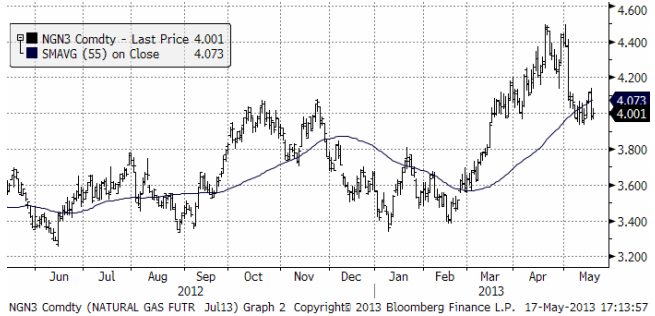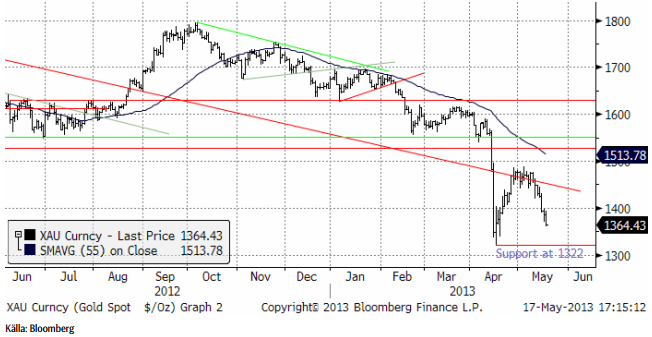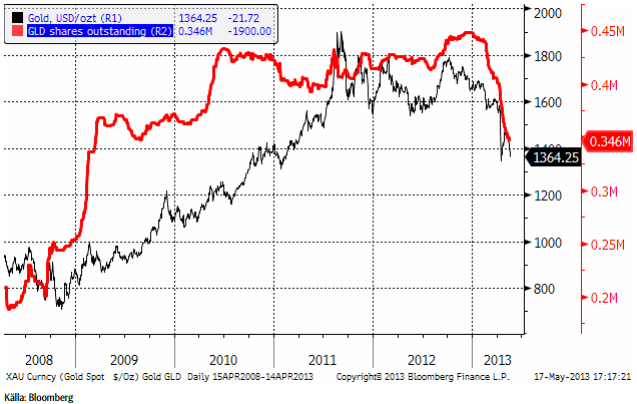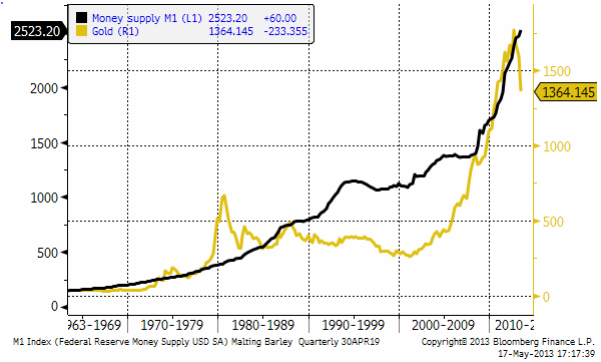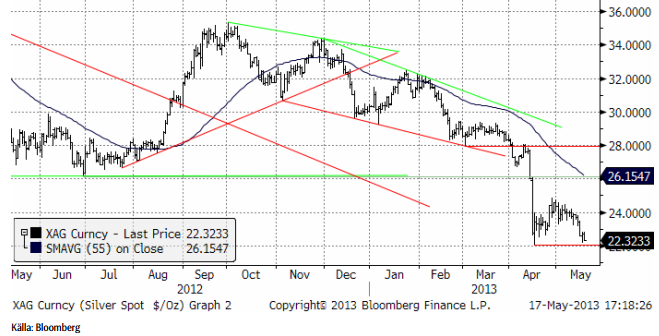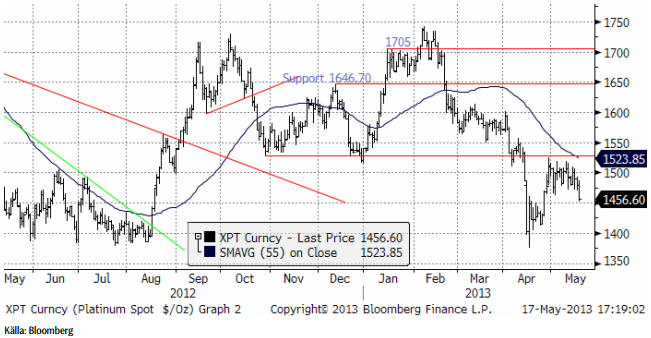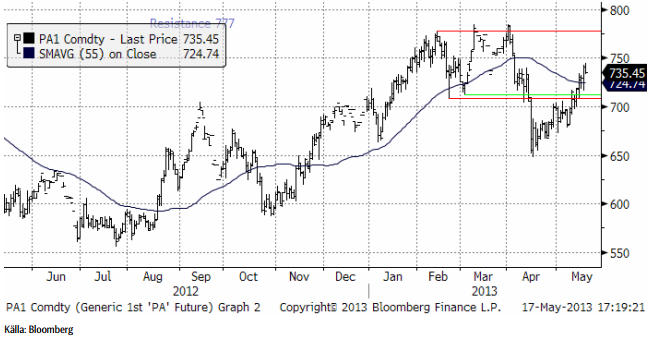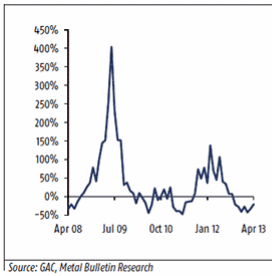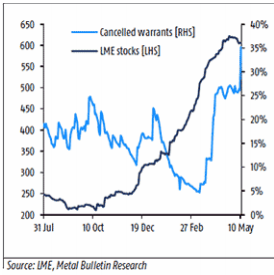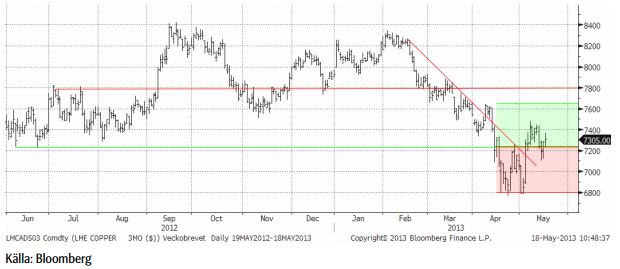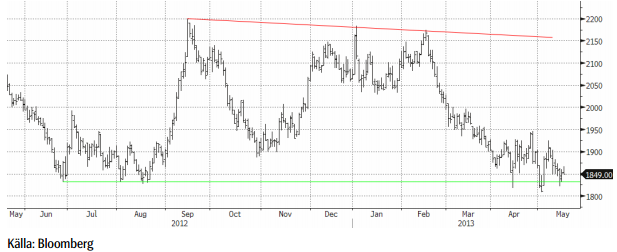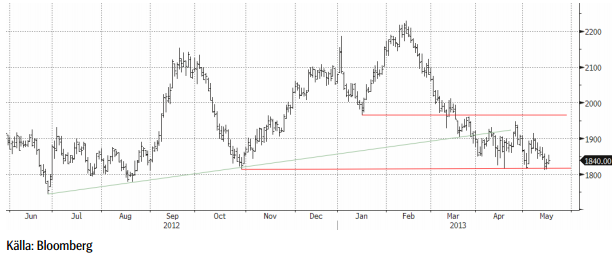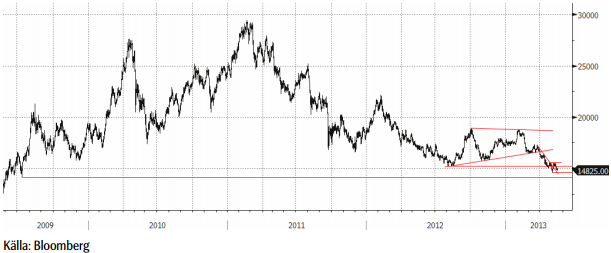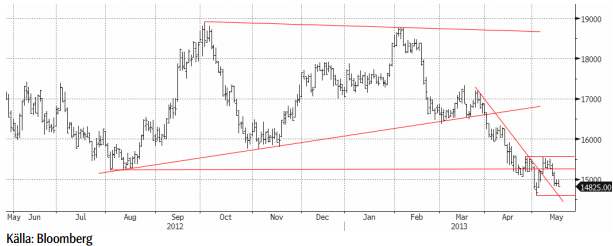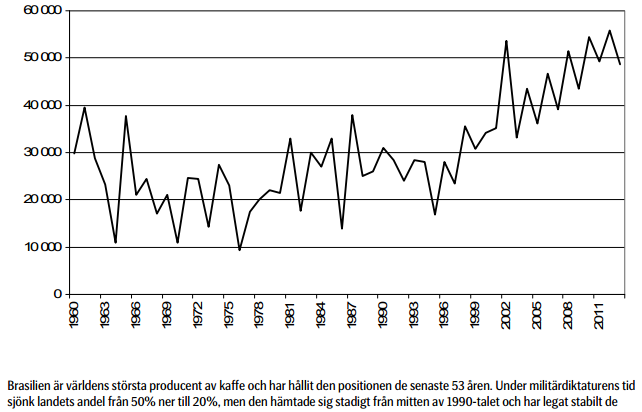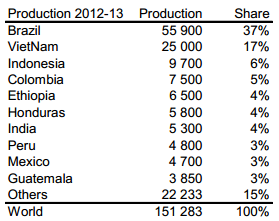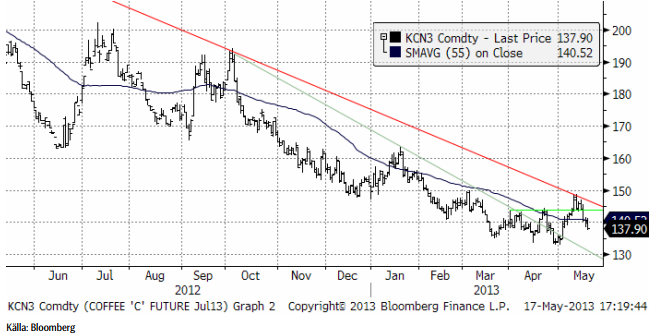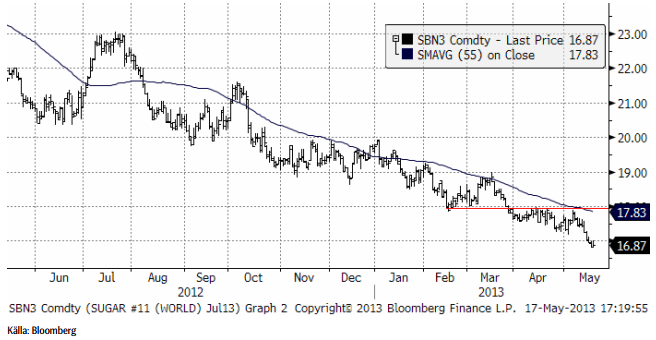Analys
SEB – Råvarukommentarer, 20 maj 2013

Rekommendationer
*) Avkastningen avser 1:1 råvarucertifikat där de ingår i rekommendationen. I den aktuella tabellen ovan har jag tagit prisförändringen den senaste veckan sedan det förra veckobrevet publicerades.
Inledning
Råvarumarknaden har fortsatt att vara svag i veckan som gick. WASDE-rapporten börjar sjunka in hos “ags” marknaden. Sådden av majs väntas ha tagit ett rekordstort kliv framåt, vilket kommer att visa sig på måndagskvällen, när USDA publicerar siffrorna. Guldmarknaden följer ett klassist mönster för en kraschande marknad. Jag tror inte att prisfallet är över än.
Råolja – Brent
Oljan var upp vid tidigare stödet (nu motståndet) vid 105 dollar. Priset orkade inte igenom och då brukar prisfall följa. Stöd finns vid 100 dollar, men trenden är nedåtriktad i det korta perspektivet. I det långa perspektivet saknas trend för råoljan.
Lagren och lagerförändringarna i USA den senaste rapportveckan (som slutade den 10 maj) ser vi nedan, enligt Department of Energy och American Petroleum Institute.
Nedan ser vi amerikanska råoljelager enligt DOE i tusen fat. Den svarta kurvan är 2012 års lagernivåer vecka för vecka och den lilla röda linjen är 2013 års nivå.
Importen fortsätter att hålla sig under förra årets nivå. Veckans notering var nästan oförändrad från veckan innan.
Vi fortsätter att ligga neutralt för att förhoppningsvis kunna komma in billigare i OLJA S om priset går ner till 100 dollar eller lägre igen.
Elektricitet
Terminen gick i veckan upp och ”stängde gapet”, det hopp nedåt i priserna som inträffade för en dryg vecka sedan. När sådant är avklarat brukar prisfallet fortsätta i den ursprungliga riktningen, i det här fallet alltså nedåt.
Hydrologisk balans har fortsatt att stiga.
Eftersom priset trots allt kommit ner ganska långt, väljer vi att fortsätta med neutral position.
Naturgas
Tekniskt är läget osäkert, mitt emellan den övre delen och den undre delen av den senaste tidens kursintervall. Vi väljer att gå över till neutral position.
Guld & Silver
Guldpriset följer ett välkänt mönster för en kraschande marknad. Först ett kraftigt fall (i april), fyndköpare, och så säljläge igen och ett nytt prisfall som börjar lite försiktigt och sedan blir allt mer panikartat. Vi är nu nästan framme vid den punkt då paniken ska börja gripa de som har för mycket guld i sina portföljer. Sannolikheten är väldigt stor att det initiala prisfallets botten i april på 1322 dollar / ozt ska nås. Om paniken infinner sig i veckan kan prisfallet bli ännu större.
17 analytiker som tillfrågats av Bloomberg tror att priset faller i veckan som kommer. Endast 8 tror att priset stiger.
April månads fyndköpare av mynt som gjorde att the US Mint, med flera nådde försäljningsrekord, har tömt ut sina resurser. Maj ser ut att endast nå 65% av april månads försäljning enligt the US Mint. Samtidigt fortsätter ETP-innehavare dumpa sina innehav. Nedan ser vi guldpriset och antal utestående GLD-depåbevis (röd kurva).
Vad som kan ha utlöst försäljningarna var ”hacket” i kurvan på penningmängden i USA. Samtidigt började FED tala om ett slut på QE. Men som vi ser i grafen nedan, har M1 fortsatt att öka i USA. Man fick kalla fötter hos FED och fortsatte trycka pengar. Det gör att det byggs upp ett latent stöd för guldpriset, bara kursfallet tar slut.
Nedan ser vi kursdiagrammet för silver i dollar per troy ounce. Stödet på 22 dollar håller än så länge. Bryts den nivån finns inget förrän vid 20 dollar, 10% längre ner.
Jag tror att silverpriset kan gå lite lägre från dagens nivå, ner mot 22 eller 20 dollar.
Vi ligger korta guld och silver. Jag tror att det kommer en till vända ner och ligger självklart kvar med köpt position i BEAR GULD X4 S och BEAR SILVER X4 S.
Platina & Palladium
Platinapriset föll i fredags ner till den övre delen av konsolideringen efter prisfallet i april, till 1450. Det är en nivå där det kan finnas tillräckligt stöd för att hejda prisfallet, men dynamiken är ändå på nedsidan.
Palladium fortsätter att sega sig upp från förra veckans 710 dollar till 735 dollar. 750 dollar är en nivå där många nog tycker att det är allt för frestande för att inte sälja.
Vi ligger kvar såld både platina och palladium, dvs med BEAR PLATNA X4 S och BEAR PALLAD X4 S.
Basmetaller
Den internationella konjunkturen står och tvekar, och så även de industriella råvarorna. Råvarumarknaderna har under våren präglats av frågetecken kring Kina, där ekonomin inte riktigt tar den fart som väntats under de säsongsmässigt starka 2:a kvartalet. Den andra stora råvarukonsumenten, USA visar positiva tecken, men även där har tveksamhet kring konjunkturen smugit sig på marknaden. Veckans statistikskörd spädde på osäkerheten: 1. antalet personer med arbetslöshetsunderstöd steg rejält, 2. husmarknaden var svagare än väntat, 3. inflationstrycket (KPI) är svagt och 4. industriaktiviteten tvekar (Philly Fed). Samtidigt har marknaden svårt för fotnedsättning: ska Fed påbörja exitpolitiken under hösten och fasa ut värdepappersköpen på $ 85 mdr/mån? Flera Fedtal tolkas som att exitplaner övervägs – vilket ger dollarstöd, en faktor som verkar hämmande på de dollarnoterade råvarorna. Våra makroekonomer räknar dock med att Fed fortsätter året ut.
Basmetallerna låg i startgroparna för en uppgång inför veckan. Men riskaptiten infann sig inte. Kortsiktiga aktörer som positionerat sig för uppgång fick kalla fötter och sålde istället. Veckan slutar med en nedgång på 1-2 % för de stora metallerna. Nickel sticker ut med ett prisfall på 4 %.
Koppar
Som vi skrivit tidigare har vi haft kopparn under bevakning för att gå från neutral till köp. Tekniskt sett bedömde vi förutsättningarna som goda för en kortsiktig uppgång. Trots veckans tillbakagång (1,4 %), ser vi tecken på att det negativa stämningsläget kring koppar håller på att svänga om.
I förra veckan redovisade vi Kinas kopparimport som kom in fortsatt svagt i april. I nedanstående diagram ser vi förändringen på årsbasis. Den negativa förändringen avtar och enligt det cykliska mönstret förväntar vi oss en positiv utveckling under de närmsta månaderna.
Procentuell förändring av kopparimporten (årsbasis)
Ett annat tecken är förändringen av LME-lagret. Vi ser både lagerminskningar och en ökning av ”cancelled warrants”. Det senare är statistik på mängden material som är på väg att plockas ur lager. Uttagen sker i Sydkorea och tyder på ökad efterfrågan – sannolikt med destination Kina. Detta stämmer överens med den förväntade ökningen av importen till Kina. Kineserna brukar utnyttja prisskillnaden mellan LME och Shanghai, som nu efter prisnedgången är till LME:s fördel.
Tekniskt sett fokuserar vi på ”dubbelbotten” från april och maj, som ger en potentiell uppgång till $7620, där motståndet sätter in. Nästa nivå är $7800. Den omedelbara pressen på koppar verkar vara över och den nedåtgående trenden är bruten. Den generella trenden får betraktas som mer sidledes för koppar.
Vi förväntar oss fortsatt hög volatilitet. Vår kortsiktiga bedömning talar för uppsidan och vi rekommenderar därför köp av BULL KOPPAR X2 S eller X4 S.
Aluminium
Priset har nu ”testat” stödnivåerna vid $1810-20 vid tre tillfällen, och lyckats studsa upp. Det är ett styrketecken. Vi ser fysiska aktörer som går in och täcker in framtida konsumtion via terminsköp vid varje dipp. Tekniskt orienterade fonder säljer vid varje uppställ. Trenden blir därefter, det rör sig sidledes. Vi ser tecken på att marknaden håller på att bottna ur. Högkostnadsproducenterna, framför allt i Kina, förväntas minska utbudet (ännu mer) om priset långvarigt stannar på nuvarande nivåer.
Långsiktigt är nivån väldigt intressant för kontraktet Aluminium S (utan hävstång).
Zink
Situationen för zink påminner om den för aluminium, både fundamentalt och tekniskt. Vi bedömer zinken som ”billig” ur ett kostnadsperspektiv och nuvarande nivåer är mycket intressanta på lite längre sikt (6-12 månader). I det perspektivet är Zink S (utan hävstång) att föredra.
Nickel
Nickel uppvisade förnyad svaghet i veckan och faller med 4 %. Trots väldigt goda efterfrågeutsikter på sikt, där den rostfria- och specialstålproduktionen förväntas öka med fortsatt utbyggnad av olje- och gasproduktion och specialstål till flygindustrin, ”lider” nickelmarknaden av ett överskott. Produktionstekniken av s.k. Nickel Pig Iron i Kina har utvecklats med s.k. Rotary Kiln Electric Furnaces (RKEF) teknik, vilken i genomsnitt sänker hela kostnadskurvan. Samtidigt får högkostnadsproducenterna i gruvledet problem på nuvarande nivåer. Vi har tidigare rapporterat om produktionsneddragningar i Australien, och det förväntas komma mer.
Effekten av RKEF-tekniken riskerar att flytta ner nivån där utbudsminskningarna verkligen får effekt. Priset har brutit viktiga stödnivåer, och vi får gå tillbaka till juli 2009 för att hitta lägre priser. I det perspektivet kommer nästa stora stödnivå in kring $14000. Vi är inte så långt därifrån och vi bedömer nivåerna från dagens pris kring $14800 ned mot nivån som väldigt attraktiva på 6-12 månaders sikt. I det perspektivet är Nickel S (utan hävstång) att föredra.
Nickel 2009-2013
Nickel på kort sikt
För veckan, och ur ett tekniskt perspektiv, gäller det att nivån från i början av månaden $14600 håller, för att undvika en test av lägre nivåer. Det finansiella kollektivet är väldigt ”korta” och frågan är hur mycket mer kraft det finns för att pressa priset ytterligare. Det byggs upp ett stort behov av att köpa tillbaka kortpositioner, vilket i sig kan skapa kraftiga rekyler på uppsidan.
Kaffe
Årets skörd i år i Brasilien är en mellanårsskörd för arabica. Conab i Brasilien publicerade en rapport den 14 maj på 48.59 miljoner säckar (à 60 kg). Enligt Conabs statistikserie blir det den största skörden någonsin för Brasilien. Om man jämför med det amerikanska jordbruksdepartementets tidsserie är skörden något lägre än 2011/12.
Nedan ser vi Brasiliens produktion i 1000 säckar. Den sista noteringen, för 2013/14, är hämtad från Conabs prognos. Resten är USDA:s data.
Brasilien är världens största producent av kaffe och har hållit den positionen de senaste 53 åren. Under militärdiktaturens tidsjönk landets andel från 50% ner till 20%, men den hämtade sig stadigt från mitten av 1990-talet och har legat stabilt de senaste 13 åren. Vietnam producerar uteslutande den sämre kaffesorten robusta. Den odlas också i delstaten Espirito-Santo i nordöstra Brasilien. Just den delen av Brasilien har varit ovanligt torrt, vilket kan ge lite mindre skörd av robusta.
The International Coffee Organisation har nyligen publicerat en rapport om kaffeblads rosten (roya). De väntar sig att den ska ha långvarig negativ effekt på produktionen. Däri ligger kanske fröet för nästa uppgång, men just nu är trenden nedåt. Marknadens försök att handla upp priset misslyckades.
Sedan mars månad har däremot inte priset fallit som tidigare. Vi har först sett lägre bottnar, men uppgångarna har varit lika högre som föregående eller högre. Kanske håller något på att hända i kaffemarknaden.
Vi tror man kan försöka sig på att köpa kaffe för lite längre sikt, t ex KAFFE S. En stopp-loss på 132 (basis juli-kontraktet) bör man dock ha.
Socker
Marknadsföringsårets 2013/14 skörd av sockerrör har börjat i Centro-Sud i Brasilien. Hittills i maj har vädret varit gynnsamt för skördearbetet. Cepea rapporterar att köpare är avvaktande, eftersom det finns en förväntan om lägre priser när ”crushen” kommit längre.
Vi fortsätter med neutral rekommendation.
[box]SEB Veckobrev Veckans råvarukommentar är producerat av SEB Merchant Banking och publiceras i samarbete och med tillstånd på Råvarumarknaden.se[/box]
Disclaimer
The information in this document has been compiled by SEB Merchant Banking, a division within Skandinaviska Enskilda Banken AB (publ) (“SEB”).
Opinions contained in this report represent the bank’s present opinion only and are subject to change without notice. All information contained in this report has been compiled in good faith from sources believed to be reliable. However, no representation or warranty, expressed or implied, is made with respect to the completeness or accuracy of its contents and the information is not to be relied upon as authoritative. Anyone considering taking actions based upon the content of this document is urged to base his or her investment decisions upon such investigations as he or she deems necessary. This document is being provided as information only, and no specific actions are being solicited as a result of it; to the extent permitted by law, no liability whatsoever is accepted for any direct or consequential loss arising from use of this document or its contents.
About SEB
SEB is a public company incorporated in Stockholm, Sweden, with limited liability. It is a participant at major Nordic and other European Regulated Markets and Multilateral Trading Facilities (as well as some non-European equivalent markets) for trading in financial instruments, such as markets operated by NASDAQ OMX, NYSE Euronext, London Stock Exchange, Deutsche Börse, Swiss Exchanges, Turquoise and Chi-X. SEB is authorized and regulated by Finansinspektionen in Sweden; it is authorized and subject to limited regulation by the Financial Services Authority for the conduct of designated investment business in the UK, and is subject to the provisions of relevant regulators in all other jurisdictions where SEB conducts operations. SEB Merchant Banking. All rights reserved.
Analys
Brent crude ticks higher on tension, but market structure stays soft

Brent crude has climbed roughly USD 1.5-2 per barrel since Friday, yet falling USD 0.3 per barrel this mornig and currently trading near USD 67.25/bbl after yesterday’s climb. While the rally reflects short-term geopolitical tension, price action has been choppy, and crude remains locked in a broader range – caught between supply-side pressure and spot resilience.

Prices have been supported by renewed Ukrainian drone strikes targeting Russian infrastructure. Over the weekend, falling debris triggered a fire at the 20mtpa Kirishi refinery, following last week’s attack on the key Primorsk terminal.
Argus estimates that these attacks have halted ish 300 kbl/d of Russian refining capacity in August and September. While the market impact is limited for now, the action signals Kyiv’s growing willingness to disrupt oil flows – supporting a soft geopolitical floor under prices.
The political environment is shifting: the EU is reportedly considering sanctions on Indian and Chinese firms facilitating Russian crude flows, while the U.S. has so far held back – despite Bessent warning that any action from Washington depends on broader European participation. Senator Graham has also publicly criticized NATO members like Slovakia and Hungary for continuing Russian oil imports.
It’s worth noting that China and India remain the two largest buyers of Russian barrels since the invasion of Ukraine. While New Delhi has been hit with 50% secondary tariffs, Beijing has been spared so far.
Still, the broader supply/demand balance leans bearish. Futures markets reflect this: Brent’s prompt spread (gauge of near-term tightness) has narrowed to the current USD 0.42/bl, down from USD 0.96/bl two months ago, pointing to weakening backwardation.
This aligns with expectations for a record surplus in 2026, largely driven by the faster-than-anticipated return of OPEC+ barrels to market. OPEC+ is gathering in Vienna this week to begin revising member production capacity estimates – setting the stage for new output baselines from 2027. The group aims to agree on how to define “maximum sustainable capacity,” with a proposal expected by year-end.
While the IEA pegs OPEC+ capacity at 47.9 million barrels per day, actual output in August was only 42.4 million barrels per day. Disagreements over data and quota fairness (especially from Iraq and Nigeria) have already delayed this process. Angola even quit the group last year after being assigned a lower target than expected. It also remains unclear whether Russia and Iraq can regain earlier output levels due to infrastructure constraints.
Also, macro remains another key driver this week. A 25bp Fed rate cut is widely expected tomorrow (Wednesday), and commodities in general could benefit a potential cut.
Summing up: Brent crude continues to drift sideways, finding near-term support from geopolitics and refining strength. But with surplus building and market structure softening, the upside may remain capped.
Analys
Volatile but going nowhere. Brent crude circles USD 66 as market weighs surplus vs risk

Brent crude is essentially flat on the week, but after a volatile ride. Prices started Monday near USD 65.5/bl, climbed steadily to a mid-week high of USD 67.8/bl on Wednesday evening, before falling sharply – losing about USD 2/bl during Thursday’s session.

Brent is currently trading around USD 65.8/bl, right back where it began. The volatility reflects the market’s ongoing struggle to balance growing surplus risks against persistent geopolitical uncertainty and resilient refined product margins. Thursday’s slide snapped a three-day rally and came largely in response to a string of bearish signals, most notably from the IEA’s updated short-term outlook.
The IEA now projects record global oversupply in 2026, reinforcing concerns flagged earlier by the U.S. EIA, which already sees inventories building this quarter. The forecast comes just days after OPEC+ confirmed it will continue returning idle barrels to the market in October – albeit at a slower pace of +137,000 bl/d. While modest, the move underscores a steady push to reclaim market share and adds to supply-side pressure into year-end.
Thursday’s price drop also followed geopolitical incidences: Israeli airstrikes reportedly targeted Hamas leadership in Doha, while Russian drones crossed into Polish airspace – events that initially sent crude higher as traders covered short positions.
Yet, sentiment remains broadly cautious. Strong refining margins and low inventories at key pricing hubs like Europe continue to support the downside. Chinese stockpiling of discounted Russian barrels and tightness in refined product markets – especially diesel – are also lending support.
On the demand side, the IEA revised up its 2025 global demand growth forecast by 60,000 bl/d to 740,000 bl/d YoY, while leaving 2026 unchanged at 698,000 bl/d. Interestingly, the agency also signaled that its next long-term report could show global oil demand rising through 2050.
Meanwhile, OPEC offered a contrasting view in its latest Monthly Oil Market Report, maintaining expectations for a supply deficit both this year and next, even as its members raise output. The group kept its demand growth estimates for 2025 and 2026 unchanged at 1.29 million bl/d and 1.38 million bl/d, respectively.
We continue to watch whether the bearish supply outlook will outweigh geopolitical risk, and if Brent can continue to find support above USD 65/bl – a level increasingly seen as a soft floor for OPEC+ policy.
Analys
Waiting for the surplus while we worry about Israel and Qatar

Brent crude makes some gains as Israel’s attack on Hamas in Qatar rattles markets. Brent crude spiked to a high of USD 67.38/b yesterday as Israel made a strike on Hamas in Qatar. But it wasn’t able to hold on to that level and only closed up 0.6% in the end at USD 66.39/b. This morning it is starting on the up with a gain of 0.9% at USD 67/b. Still rattled by Israel’s attack on Hamas in Qatar yesterday. Brent is getting some help on the margin this morning with Asian equities higher and copper gaining half a percent. But the dark cloud of surplus ahead is nonetheless hanging over the market with Brent trading two dollar lower than last Tuesday.

Geopolitical risk premiums in oil rarely lasts long unless actual supply disruption kicks in. While Israel’s attack on Hamas in Qatar is shocking, the geopolitical risk lifting crude oil yesterday and this morning is unlikely to last very long as such geopolitical risk premiums usually do not last long unless real disruption kicks in.
US API data yesterday indicated a US crude and product stock build last week of 3.1 mb. The US API last evening released partial US oil inventory data indicating that US crude stocks rose 1.3 mb and middle distillates rose 1.5 mb while gasoline rose 0.3 mb. In total a bit more than 3 mb increase. US crude and product stocks usually rise around 1 mb per week this time of year. So US commercial crude and product stock rose 2 mb over the past week adjusted for the seasonal norm. Official and complete data are due today at 16:30.
A 2 mb/week seasonally adj. US stock build implies a 1 – 1.4 mb/d global surplus if it is persistent. Assume that if the global oil market is running a surplus then some 20% to 30% of that surplus ends up in US commercial inventories. A 2 mb seasonally adjusted inventory build equals 286 kb/d. Divide by 0.2 to 0.3 and we get an implied global surplus of 950 kb/d to 1430 kb/d. A 2 mb/week seasonally adjusted build in US oil inventories is close to noise unless it is a persistent pattern every week.
US IEA STEO oil report: Robust surplus ahead and Brent averaging USD 51/b in 2026. The US EIA yesterday released its monthly STEO oil report. It projected a large and persistent surplus ahead. It estimates a global surplus of 2.2 m/d from September to December this year. A 2.4 mb/d surplus in Q1-26 and an average surplus for 2026 of 1.6 mb/d resulting in an average Brent crude oil price of USD 51/b next year. And that includes an assumption where OPEC crude oil production only averages 27.8 mb/d in 2026 versus 27.0 mb/d in 2024 and 28.6 mb/d in August.
Brent will feel the bear-pressure once US/OECD stocks starts visible build. In the meanwhile the oil market sits waiting for this projected surplus to materialize in US and OECD inventories. Once they visibly starts to build on a consistent basis, then Brent crude will likely quickly lose altitude. And unless some unforeseen supply disruption kicks in, it is bound to happen.
US IEA STEO September report. In total not much different than it was in January

US IEA STEO September report. US crude oil production contracting in 2026, but NGLs still growing. Close to zero net liquids growth in total.

-

 Nyheter4 veckor sedan
Nyheter4 veckor sedanMeta bygger ett AI-datacenter på 5 GW och 2,25 GW gaskraftverk
-

 Nyheter4 veckor sedan
Nyheter4 veckor sedanAker BP gör ett av Norges största oljefynd på ett decennium, stärker resurserna i Yggdrasilområdet
-

 Nyheter4 veckor sedan
Nyheter4 veckor sedanSommarens torka kan ge högre elpriser i höst
-

 Analys4 veckor sedan
Analys4 veckor sedanBrent edges higher as India–Russia oil trade draws U.S. ire and Powell takes the stage at Jackson Hole
-

 Nyheter3 veckor sedan
Nyheter3 veckor sedanMahvie Minerals är verksamt i guldrikt område i Finland
-

 Analys4 veckor sedan
Analys4 veckor sedanIncreasing risk that OPEC+ will unwind the last 1.65 mb/d of cuts when they meet on 7 September
-

 Nyheter3 veckor sedan
Nyheter3 veckor sedanNeil Atkinson spår att priset på olja kommer att stiga till 70 USD
-

 Analys2 veckor sedan
Analys2 veckor sedanOPEC+ in a process of retaking market share


